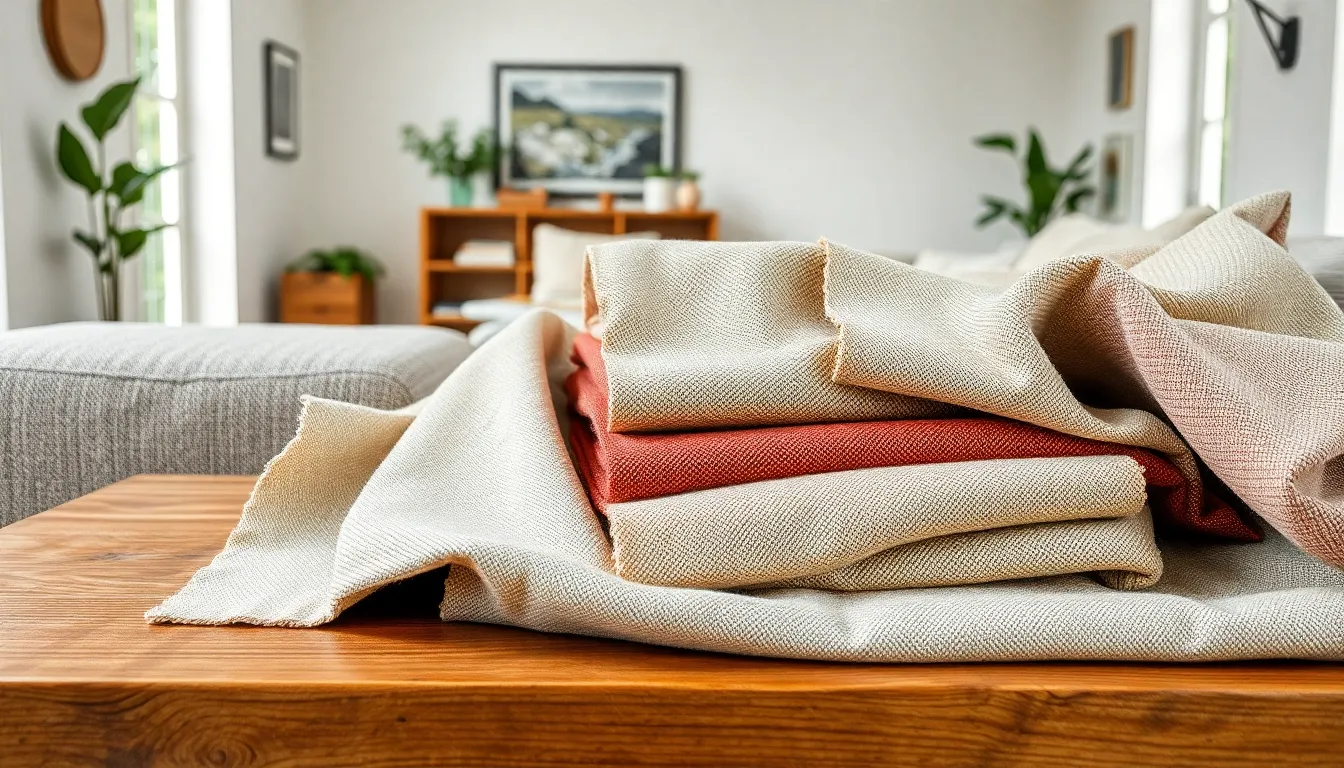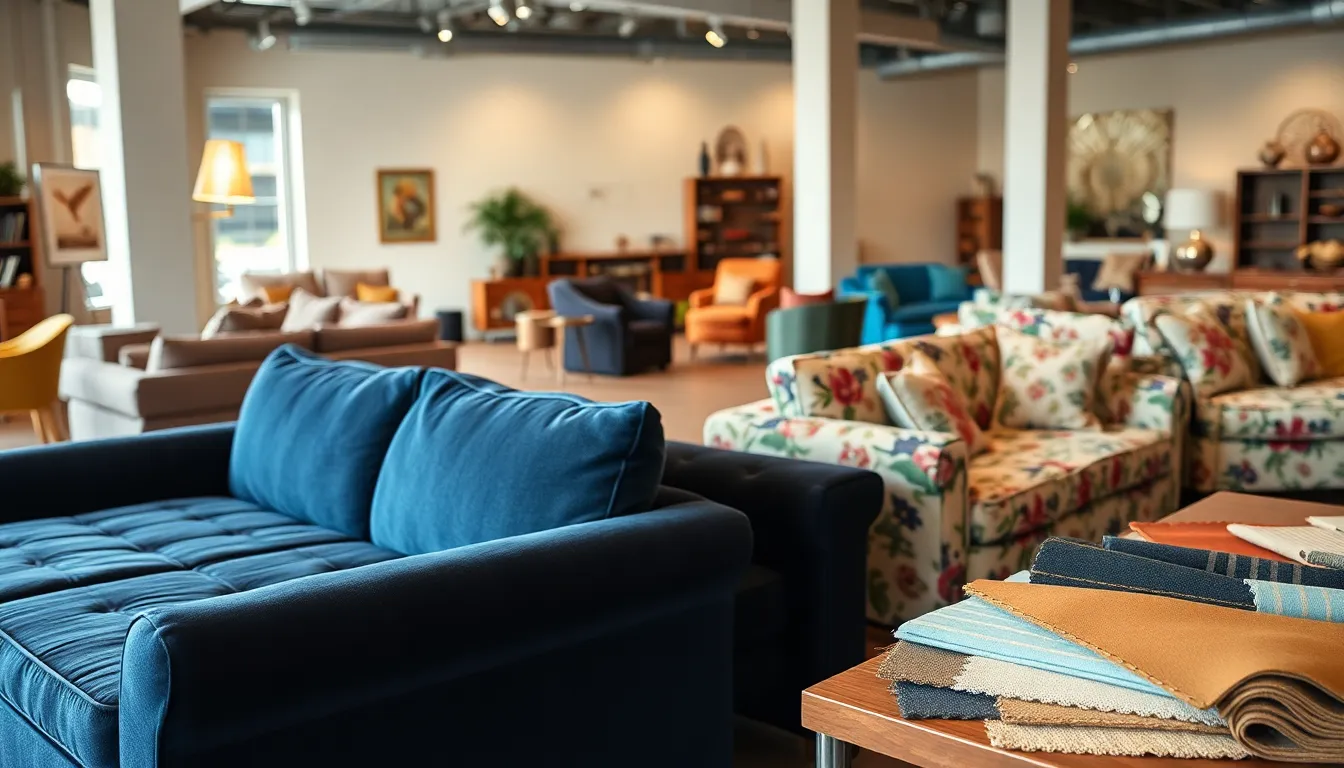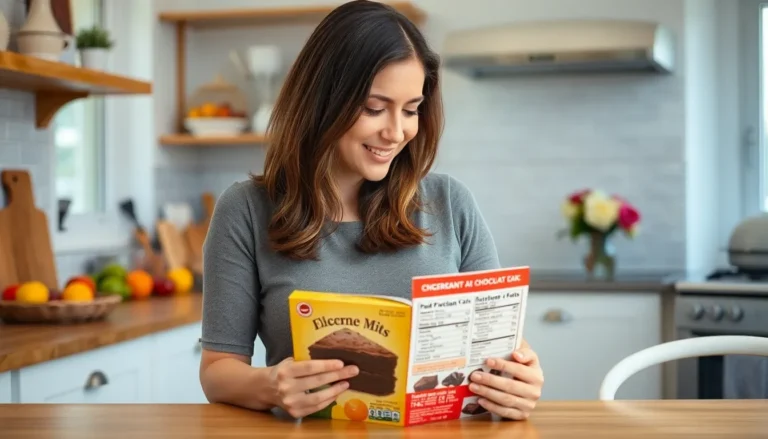Table of Contents
ToggleWhen it comes to furniture, the right upholstery fabric can make all the difference. It’s like dressing your couch for a night out—would you let it hit the town in last season’s trends? Absolutely not! Choosing the perfect fabric not only elevates the look of your space but also ensures comfort and durability, because let’s face it, that couch is going to see some serious action.
Overview of Furniture Upholstery Fabric
Furniture upholstery fabric plays a crucial role in both function and style. Various materials provide different benefits, addressing needs such as durability, comfort, and ease of maintenance. Natural fibers, like cotton and linen, offer breathability and softness, making them ideal for casual environments. Synthetic fibers, such as polyester and nylon, frequently deliver enhanced durability and stain resistance, suitable for high-traffic areas.
Different upholstery types exist to cater to specific styles and preferences. For instance, leather adds a sophisticated touch and ages well, whereas microfiber presents a soft texture and is easy to clean. The choice of fabric influences the overall aesthetic, shaping how a space feels and looks.
Color and pattern also play a significant role in fabric selection. Vibrant colors can serve as statement pieces, while subtle patterns contribute to a cohesive design. Texture varies greatly, with options from smooth to plush, impacting how individuals perceive comfort and quality.
Manufacturers often categorize upholstery fabrics based on their intended use, durability ratings, and cleaning methods. Choosing the right fabric starts by assessing the intended purpose, style preferences, and lifestyle needs. For example, households with pets might prioritize stain-resistant materials, while those seeking luxury may gravitate towards finer fabrics.
Sustainability considerations increasingly affect fabric choices. Eco-friendly options, such as organic cotton and recycled fibers, attract environmentally conscious consumers. Selecting upholstery fabric extends beyond aesthetics; it involves thoughtful consideration of practicality, comfort, and environmental impact.
Types of Furniture Upholstery Fabrics

Selecting upholstery fabrics involves understanding the different types available in the market. Each category offers unique benefits tailored to various needs.
Natural Fabrics
Natural fabrics like cotton, linen, and silk offer superior breathability and softness. Cotton provides comfort and ease of cleaning, making it ideal for family spaces. Linen delivers a textured look and natural resistance to dirt, perfect for a casual yet sophisticated design. Silk adds a touch of luxury but requires more maintenance due to its delicate nature. These fabrics often enhance a warm and inviting atmosphere in any room. Consumers value sustainable options like organic cotton, contributing to eco-friendly choices.
Synthetic Fabrics
Synthetic fabrics such as polyester, nylon, and acrylic deliver outstanding durability and stain resistance. Polyester stands out for its ability to maintain color and resist fading, suitable for high-traffic areas. Nylon offers an excellent balance of strength and flexibility, preventing wear and tear over time. Acrylic mimics wool’s warmth and texture while being easier to clean. Many homeowners appreciate these options for their low-maintenance qualities, ensuring upholstery remains vibrant and functional. Versatile synthetic choices often align with busy lifestyles, leading to their growing popularity in modern furniture.
Factors to Consider When Choosing Upholstery Fabric
Selecting upholstery fabric involves multiple considerations, primarily durability and maintenance. Understanding these factors can significantly impact the longevity and appearance of furniture.
Durability
Durability plays a crucial role in fabric selection. Fabrics are rated on their ability to withstand wear and tear, essential for high-traffic areas. Look for materials like polyester and nylon, which are known for their resilience. Natural fabrics, such as cotton and linen, while breathable, may show signs of wear faster. Thick weaves and tightly knitted fabrics often provide added strength. Consider the abrasion resistance rating, measured in double rubs, to better compare options. Fabrics falling above 15,000 double rubs offer better performance in demanding environments. By prioritizing durable materials, making long-term investments in furniture becomes easier.
Maintenance
Maintenance requirements differ significantly among upholstery fabrics. Synthetic fibers typically boast easy cleaning, resisting stains and spills effectively. Cleanability becomes critical for households with pets or children. Fabrics like microfiber can be wiped clean with a damp cloth, simplifying upkeep. On the other hand, natural fibers may require more delicate care due to their propensity to absorb stains. Determine whether a fabric can be machine washed or if a specific cleaning method is necessary. Choosing upholstery fabrics with finishes that repel liquids can also aid in simplifying maintenance, keeping furniture looking fresh over time.
Popular Patterns and Textures
Upholstery fabrics come in a variety of patterns and textures that enhance both style and functionality. Floral patterns, for example, add a touch of elegance and can brighten up any room. Geometric designs offer a modern flair, making them suitable for contemporary and minimalist spaces. Striped fabrics introduce visual interest, with vertical or horizontal lines creating an illusion of height or width, respectively.
Textures play a vital role in how a fabric feels and performs. Velvet fabrics deliver a soft, luxurious touch that elevates comfort. Linen, on the other hand, presents a more casual vibe while maintaining breathability. Leather upholstery, known for its durability, adds a classic and timeless quality, particularly in spaces that seek sophistication.
Additional textures like chenille present a cozy feel, perfect for family rooms or cozy reading nooks. Microfiber, recognized for its stain resistance, remains a popular choice for homes with children or pets. Each texture complements various patterns, enabling homeowners to mix and match styles effectively.
Furthermore, choosing upholstery fabric involves considering the lifestyle needs of the household. Busy environments benefit from durable and easy-to-clean options like polyester blends. For those seeking a balance between aesthetics and practicality, fabrics with intricate patterns and robust textures provide both visual appeal and long-lasting performance.
Visit fabric stores or browse online galleries to observe samples in person. Observing how light interacts with fabrics makes it easier to select the best match for a specific space. Exploring different combinations of patterns and textures unlocks endless possibilities for personal expression in furniture design.
Eco-Friendly Upholstery Options
Sustainable upholstery options appeal to environmentally conscious consumers. Natural fabrics like organic cotton and linen reduce chemical exposure and support eco-friendly practices. Recycled polyester showcases durability while minimizing waste, making it equally appealing for various furniture types.
Consistent production processes also matter. Fabrics produced with low-impact dyes preserve environmental integrity while maintaining aesthetic appeal. Additionally, options like hemp offer natural resistance to mold and UV rays, emphasizing sustainability without sacrificing quality.
Performance characteristics enhance these eco-friendly choices. Organic wool exhibits natural stain resistance, providing a practical choice for households with pets and children. Bamboo fabric stands out due to its fast growth and minimal pesticide use, presenting another strong contender.
Manufacturers increasingly focus on certifications to ensure environmental responsibility. Look for labels like GOTS or OEKO-TEX, which verify organic content and safe processing methods. Transparent sourcing promotes sustainability and encourages consumers to make informed decisions.
Choosing eco-friendly upholstery reflects personal values and lifestyle needs. While considering aesthetic elements, prioritize durability to extend the lifespan of furniture pieces. Explore local artisans who specialize in sustainable practices for unique options tailored to individual tastes. By selecting eco-friendly upholstery fabrics, individuals contribute to a healthier planet and create comfortable living spaces.
Choosing the right upholstery fabric is essential for creating a beautiful and functional living space. By considering durability comfort and style individuals can make informed decisions that enhance their furniture’s appeal. Whether opting for natural fibers or synthetic options each choice presents unique benefits tailored to specific needs.
Sustainability is also a key factor in today’s market with eco-friendly materials offering a responsible way to furnish homes. Exploring various patterns textures and colors allows for personal expression while ensuring the furniture remains practical for everyday use.
Ultimately the right upholstery fabric can transform a room making it not just stylish but also a reflection of individual values and lifestyle.








